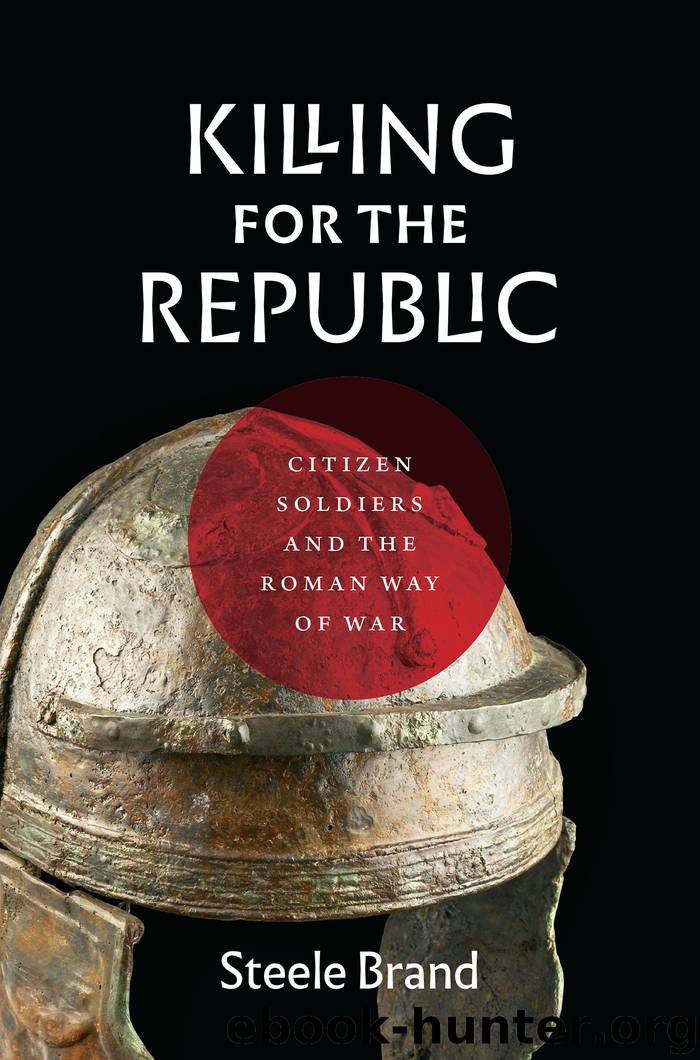Killing for the Republic by Steele Brand

Author:Steele Brand [Brand, Steele]
Language: eng
Format: epub
ISBN: 9781421429861
Publisher: Johns Hopkins University Press
Published: 2019-01-15T07:00:00+00:00
GLORIFIED VICTORS
Paullus followed up his victory with the occupation and administration of Macedonia. The Roman army was warmly received by a number of Macedonians who had grown weary of Perseus’ rule. Paullus stopped at Amphipolis, where “the pouring out of the entire populace to meet him showed to any one that Paullus had not robbed them of a just and good king” (Livy, 44.46). Later that year at Samothrace, Perseus and his children were captured, shackled, and carried off to Rome (Livy, 45.6). In 167, Paullus summoned representatives from throughout Macedonia and disseminated Rome’s terms at Amphipolis, namely that Macedonia would keep its own laws, be divided into four, and be made directly subject to Rome (Livy, 45.29–32).17 The historians claim that many Macedonian subjects were relieved and satisfied with the terms. This was due in no small part to Paullus’ “occupying himself in ways alike honorable and humane” (Plutarch, Aemilius Paulus, 28–29). Paullus even celebrated a festival replete with games, sacrifices, banquets, and other entertainments (Plutarch, Aemilius Paulus, 29). “The man who knew how to conquer in war,” Paullus quipped during the revelry, “could also arrange a banquet and organize games” (45.32).
Or so we are told. The beneficence the authors credit Paullus with and the cheerful resignation of the Macedonians at Amphipolis was hardly the whole truth. In Epirus, for example, Paullus’ lieutenants sacked seventy communities, tore down their walls, enslaved 150,000 civilians, sold off the booty, and divvied up the proceeds between the cavalry and infantry. Incidentally, the infantrymen were not satisfied with their share and later complained of their treatment, precipitating a crisis that threatened his triumph (Livy, 45.34).
Paullus used some of the proceeds to modify the pillar at Delphi that Perseus had intended to top with a statue of himself. When Paullus saw it, he snidely remarked that “the conquered should make room for their conquerors” (Plutarch, Aemilius Paulus, 28; Livy, 45.27). Of all the Roman symbols to choose from, the question then was what should replace the dethroned king? A statue of Paullus himself of course!
Unfortunately, what remains to us today from Paullus’ Delphic modifications is only a set of friezes. Not surprisingly, most of what survives is a depiction of the aristocratic cavalry at Pydna. Their distinguished role in the battle was to accidentally stumble into their opponents and launch the fighting, and yet these were the men Paullus made sure to glorify in stone. They were likely featured at the most prominent position at the monument’s top, just beneath the imperator himself.18 Overall, Paullus represented magisterial imperium to the full. He dealt out justice (and some injustice), distributed spoils, delighted crowds, delivered vengeance, and magnified the accomplishments of himself and his class.
Download
This site does not store any files on its server. We only index and link to content provided by other sites. Please contact the content providers to delete copyright contents if any and email us, we'll remove relevant links or contents immediately.
| Africa | Americas |
| Arctic & Antarctica | Asia |
| Australia & Oceania | Europe |
| Middle East | Russia |
| United States | World |
| Ancient Civilizations | Military |
| Historical Study & Educational Resources |
The Mysteries of Mithra by Cumont Franz(1330)
The Fall of Carthage by Adrian Goldsworthy(1281)
Sacred Britannia: The Gods and Rituals of Roman Britain by Aldhouse-Green Miranda(1133)
Letters from a Stoic (Classics) by Seneca(994)
The Ghosts of Cannae: Hannibal and the Darkest Hour of the Roman Republic by Robert L. O'Connell(968)
Selected Political Speeches by Marcus Tullius Cicero(957)
The Satyricon by Petronius(955)
The Poison King: The Life and Legend of Mithradates, Rome's Deadliest Enemy by Adrienne Mayor(947)
Fall of the Roman Republic (Penguin Classics) by Plutarch(946)
Rome's Gothic Wars: From the Third Century to Alaric by Michael Kulikowski(920)
Rubicon: The Triumph and Tragedy of the Roman Republic by Tom Holland(913)
Hadrian and the Triumph of Rome by Everitt Anthony(868)
In Defence of the Republic by Cicero(849)
The Roman History by Cassius Dio(829)
Delphi Complete Works of Cicero by Cicero(803)
Letters from a Stoic by Seneca(782)
The Spartacus War by Strauss Barry(764)
The Twelve Caesars (Penguin Classics) by Suetonius & Robert Graves(760)
Marcus Aurelius by John Sellars(760)
